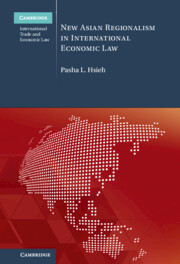Book contents
- New Asian Regionalism in International Economic Law
- Cambridge International Trade and Economic Law
- New Asian Regionalism in International Economic Law
- Copyright page
- Contents
- Figures
- Tables
- Preface
- Abbreviations
- 1 Introduction: New Asian Regionalism As a Global Paradigm Shift
- 2 The Legalization of the ASEAN Economic Community
- 3 Signing the RCEP As a Milestone
- 4 Constructing Interregionalism: The New EU Strategy to Asia
- 5 Revitalizing the US Pivot to Asia
- 6 The Marginalization or Rejuvenation of APEC?
- 7 Conclusion
- Select Bibliography
- Index
6 - The Marginalization or Rejuvenation of APEC?
Published online by Cambridge University Press: 03 December 2021
- New Asian Regionalism in International Economic Law
- Cambridge International Trade and Economic Law
- New Asian Regionalism in International Economic Law
- Copyright page
- Contents
- Figures
- Tables
- Preface
- Abbreviations
- 1 Introduction: New Asian Regionalism As a Global Paradigm Shift
- 2 The Legalization of the ASEAN Economic Community
- 3 Signing the RCEP As a Milestone
- 4 Constructing Interregionalism: The New EU Strategy to Asia
- 5 Revitalizing the US Pivot to Asia
- 6 The Marginalization or Rejuvenation of APEC?
- 7 Conclusion
- Select Bibliography
- Index
Summary
The chapter explores the origin of APEC’s trans-regional structure and operating mechanism, which is based on the 1995 Osaka Action Agenda designed to fulfil the Bogor Goals. It also explains APEC’s credibility crisis due to the failure of premature liberalization efforts and its inability to assist countries during the Asian financial crisis. Furthermore, the chapter provides insight into key APEC members’ legal and political approaches that have affected APEC’s evolution and agendas. For instance, the US Indo-Pacific strategy, China’s Belt and Road Initiative and ASEAN’s AEC Blueprint 2025 have influenced APEC’s current connectivity initiative involving infrastructure development. To evaluate APEC’s incremental achievements, the chapter centers on APEC’s FTA-related model measures, trade facilitation essential to the regional supply chain, and tariff liberalization for information technology and environmental products. Finally, taking into account the APEC Putrajaya Vision 2040, the chapter provides recommendations for APEC’s legal and institutional reforms. The feasible pathways to the FTAAP, including the CPTPP and the RCEP, will also be examined in the context of new Asian regionalism.
- Type
- Chapter
- Information
- New Asian Regionalism in International Economic Law , pp. 197 - 234Publisher: Cambridge University PressPrint publication year: 2021

